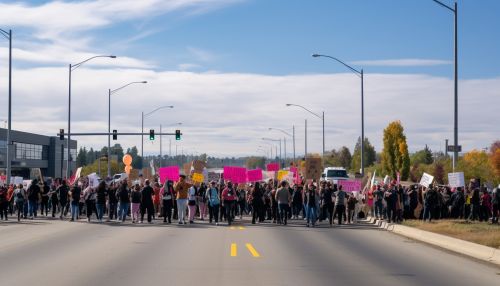Nonviolent resistance
Introduction
Nonviolent resistance, also known as nonviolent action, is a practice of achieving goals such as social or political change through symbolic protests, civil disobedience, economic or political noncooperation, and other methods, without using violence. This form of resistance has been a significant method of social and political change throughout history and across the globe. It is often associated with the advancement of civil rights, political freedoms, and social justice.
Historical Overview
The concept of nonviolent resistance has roots in ancient times. However, it was Gandhi's nonviolent movement in India that brought the strategy to a global stage. Gandhi's approach was not just a strategy for resisting British rule, but a way of life that emphasized the power of truth and love over violence.


In the 20th century, nonviolent resistance played a crucial role in the American Civil Rights Movement. Leaders like Dr. Martin Luther King Jr. were inspired by Gandhi's philosophy and applied it to their struggle for racial equality.
Principles of Nonviolent Resistance
Nonviolent resistance is based on several key principles. These principles include the belief in the inherent dignity of all people, the power of truth, the effectiveness of persuasion over coercion, and the necessity of moral or ethical consistency.
Methods of Nonviolent Resistance
Nonviolent resistance can take many forms, from symbolic protests and demonstrations to civil disobedience and noncooperation. These methods are often used in combination to maximize their impact. For example, a movement may begin with symbolic protests to raise awareness of an issue, then escalate to civil disobedience if the initial protests do not result in the desired change.
Effectiveness of Nonviolent Resistance
Research has shown that nonviolent resistance can be highly effective. A study by political scientists Erica Chenoweth and Maria J. Stephan found that nonviolent campaigns were twice as likely to achieve their goals as violent campaigns. They also found that nonviolent resistance was more likely to lead to democratic outcomes and less likely to result in civil war.
Critiques and Limitations
While nonviolent resistance has been successful in many cases, it is not without its critiques and limitations. Some argue that nonviolent resistance is only effective in certain contexts, or that it can be co-opted by those in power. Others point out that nonviolent resistance often requires a high level of organization, discipline, and strategic planning, which may not be possible in all situations.
Conclusion
Nonviolent resistance is a powerful tool for social and political change. It has been used successfully in many contexts, from the civil rights movement in the United States to the struggle for independence in India. While it is not without its challenges and limitations, the potential of nonviolent resistance to bring about significant change is undeniable.
